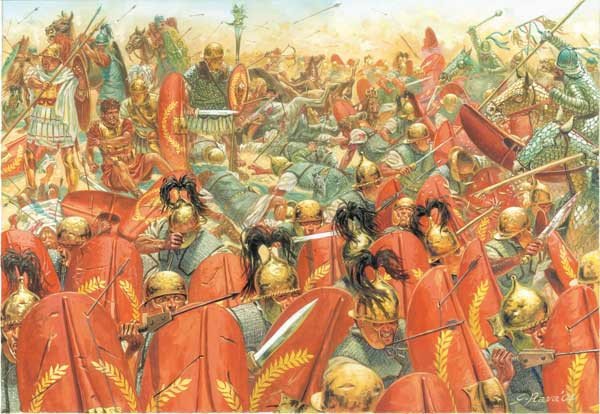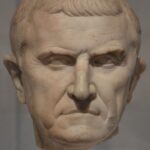Chapters
Battle of Carrhae (53 BCE) was one of the greatest defeats suffered by Roman legions in their history. Crassus himself died on the battlefield.
Background of events
In 54 BCE Marcus Crassus, one of the triumvirs, after serving his consulate in Rome, went to Syria to follow the arrangements of the Triumvirs’ convention in Lucca with 56 BCE, take the governorship of this province. The neighbourhood of the wealthy Party, which controlled part of the Silk Road, and the trade between the Mediterranean world and India, captured the imagination of Crassus, who wanted easy Roman conquests in the East. He also wanted to match the fame of the other triumvirs: Julius Caesar and Pompey.
Soon Crassus began preparations for a Parthian expedition. In 54 BCE at the head of his army, he crossed to the other side of the Euphrates, occupying several cities, some of which surrendered voluntarily. Leaving a few garrisons in Mesopotamia, he returned with the rest of the army to winter quarters in Syria. This delay in action was, according to Plutarch, the cause of the further failures of Marcus Crassus. At the end of 54 BCE Crassus’s son, Publius Crassus, a former brave legate of Caesar in Gaul, who had brought with him a unit of 1,000 horsemen of Gallic cavalry with him, came to Syria. In 54 BCE Crassus’ 36,000 army (seven legions, cavalry of Publius Crassus and allies) crossed the Euphrates near the city of Zeugma and at the beginning of 53 BCE. was in Parthian-controlled Mesopotamia. His natural ally, the king of Armenia Artawazdes II, entered into an alliance with Crassus, who persuaded Crassus to march to the Party through Armenia, which was safer for the Romans. Crassus, however, preferred a shorter route through the desert country towards Seleucia and the Parthian capital of Ctesiphon, so Artavazdes II withdrew with his troops. The Romans were also joined by 6,000 cavalry Ariamnes, the leader of the Arab Nataban, who later turned out to be an ally of the Parthians and led the legions into a trap, dragging them away from the river and leading them into desert areas.
The party king Orodes II divided his army into two parts and went to Armenia himself to punish Artawazdes II. The remaining troops, numbering about 10,000 horse archers and 1,000 heavily armed horsemen (cataphracts) under the leadership of the outstanding Parthian leader Eran Spahbodh Rustaham Surenas-Pahlav were to delay the Roman march until they returned from the north King Orodes.
Roman forces | Parthian forces |
Command: Marcus Licinius Crassus and Publius Crassus The strength was 39,000 legionaries, including 4,000 cavalry | Command: Eran Surenas The strength was around 9,000 horse archers, including 1,000 cataphracts |
Battle
Crassus marched along the Euphrates without encountering the slightest resistance, but only traces of the troops escaping before him. So when he came across a Parthian army some 35 km south of Carrhae (now Harran in Turkey), he was very surprised. He ordered his legionaries to form the so-called “turtle”. Each side of the formation had 12 cohorts and a cavalry unit. The wings were commanded by Publius Crassus and legate Cassius, and Marcus Crassus remained in the centre of the square. In this formation, the Romans reached the Balissus stream (now Balikh). Most Roman commanders were in favour of setting up a camp and staying in this place overnight and getting information about the enemy numbers. His son persuaded Crassus to act quickly. He was confident in seeing only light archers. He did not know that the Parthian leader ordered his cataphracts to cover their armour with skins and hide behind the front lines. Suddenly, in the deafening and terrifying rumble of tarabans, the cataphracts threw off their armour and launched an attack on the Romans. When Suren realized the depth of the Roman army that could withstand the impact of the attack, he stopped the heavy charge and ordered the enemy to surround him. The Romans counterattacked but were stopped by a barrage of arrows that pierced Roman shields and armour. Mounted archers began to shower arrows helpless, who could only protect themselves behind the Roman shields. A thousand Arab camel riders provided an uninterrupted supply of arrows for the Parthian archers.
Marcus Crassus ordered Publius Crassus to charge the Parthian troops with a charge. Publius led 1,300 horsemen, 500 archers and eight cohorts of legionaries there. The Gallic horsemen, who fought with great courage and determination, were nevertheless defeated by cataphracts, and Publius, not wanting to be captured, took his own life. His severed head stuck on a spear, the Parthians showed to the Romans. The main Roman forces were massacred with arrows until nightfall when the Parthians retreated.
After darkness fell, the initiative was taken over by Crassus’ legates, Cassius and Octavius, who hoped for survival in a quick retreat to the walls of Carrhae. Before midnight, a cavalry unit arrived in the city, ahead of the main forces retreating into chaos, which the cavalrymen did not wait for, retreating towards the Euphrates. The two-thousand-strong Roman infantry detachment, which broke away from the main column, was carved into the trunk by the Parthians chasing the Romans. Crassus’ army was brought into the city by the commander of the Roman garrison, who came to the aid of Crassus. Meanwhile, Carrhae had no supplies to withstand the long siege. The defenders could not count on outside help either. So Crassus decided to leave the next night and seek refuge in Armenia. However, his guide turned out to be a Parthian sympathizer who deceived the Romans all night long.
Consequences
Cassius with five hundred horsemen managed to reach Syria safely. Octavius, another officer, took refuge in the mountains thanks to trusted guides. At dawn, Crassus, at the head of the remnants of his forces, approached the foot of the mountain range and joined with Octavius. At this point, Surenas’ messengers offered Crassus peace deals. With no way out, Crassus and Octavius met the Parthians. During the talks, a skirmish took place, probably by accident, during which Crassus died at the hands of some lesser party commander.
Part of the legionaries broke away from their army and went east to avoid battle. There are many indications that deserters played the role of mercenaries during the armed conflict between the Huns and the Chinese in 36 BCE. In the 1st century CE and they were to settle in the area now inhabited by their Chinese descendants. Earlier theories suggested that the blood of the soldiers who served in the Roman legions flows in the veins of the people inhabiting the small settlement of Liqian. Now, these theories are supported by the facts. The DNA tests carried out showed that their genetic code largely coincides with the material of the white race. As many as 2/3 of the villagers could have had ancestors representing the white race.
Analyzes already carried out by anthropologists showed that something was up. Scientists pointed to the characteristic features of the appearance of the inhabitants of a village located in northwest China. Many of them have blue or green eyes, long noses, and blonde hair. The villagers themselves are also sure of their European roots. Some even have nicknames that refer to their supposed origins. One of them tells him to call Cai Roman.
About 20,000 legionaries were killed and 10,000 captured during the Battle of Carrhae. The latter was settled in Sogdiana in the eastern part of the Parthian empire. The Parthians fell into 7 legionary insignia, the return of which he negotiated only in 20 BCE. Emperor Augustus.













